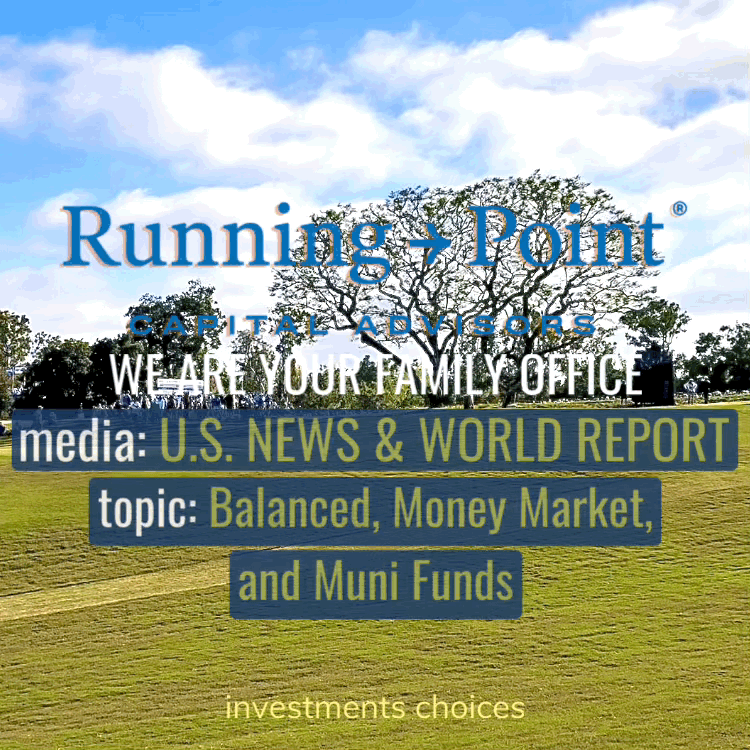A field of funds
Running Point and its chief investment officer, Michael Ashley Schulman, CFA, were recently quoted in three separate articles by U.S. News & World Report regarding our thoughts on balanced funds, money market funds, and municipal bond funds.
- By Tony Dong and edited by Geoffrey Smith, “7 Best Balanced Funds to Pick Right Now”, May 25, 2023
- By Tony Dong and edited by Geoffrey Smith, “7 Best Money Market Funds for 2023”, May 31, 2023
- By Tony Dong and edited by Geoffrey Smith, “7 of the Best Tax-Free Municipal Bond Funds”, June 29, 2023
Much as ever, people continue to seek safe, profitable, and interesting ways to invest; and as ever, seeking professional fiduciary advice can be a great benefit.
1) Best Balanced Funds 💵
Consider your financial goals: There are various flavors, or subcategories, of balanced funds that cater to spectrum of different investment objectives and risk tolerances from conservative, to moderate, to aggressive. The specific asset allocation and investment strategy of balanced funds varies among different financial managers and institutions. Investors should consider seeking advice from a multifamily office or other fiduciary when analyzing investment choices.
Conservative balanced funds tend to prioritize capital preservation and income generation by having a higher allocation of debt securities, aiming for stability and regular income, with a smaller allocation to stocks for modest growth potential. Whereas aggressive balanced funds usually have a higher allocation to equities for greater capital growth potential and longer investment time horizons.
Income-focused balanced funds, for investors seeking regular cash flow, prioritize generating steady income for investors, typically through a higher allocation to bonds, dividend-paying stocks, and other income-generating assets.
What 20/80, 30/70, or 60/40 means: In typical vernacular, a conservative fund might be considered a 20/80 or 30/70 and an aggressive fund might be 80/30 or 70/30. In this parlance the first number describes the fund’s investment allocation to equities and the second number the allocation to debt. Thus, a conservative fund might have only 20% or 30% of the fund devoted to equity investments and 80% or 70% respectively allocated to debt. Close to the middle, a 60/40 fund may be considered moderately aggressive and a 40/60 fund moderately conservative. However, check the fund’s documentation because some managers quote the debt allocation first and the equity allocation second.
What to look for: When evaluating balanced funds, consider looking for a low expense ratio and no 12b-1 fees, as they directly affect your investment returns by reducing costs, low portfolio turnover, as it reduces transaction costs and potential tax implications, the specific indices and diversification requirements of the fund to analyze historical tracking error, financial metrics such as yield (for income-focused funds), credit quality, and credit ratings to understand income generation, stability, and creditworthiness, fund manager expertise, and fund size/liquidity. Additionally, check the commission or transaction fees associated with buying or selling a specific fund on your brokerage or account platform; some funds trade for zero fees on some platforms whereas others may incur a charge.
Quoted article excerpts:
“A balanced fund is a diversified investment fund that provides a combination of growth and income by investing across a mix of stocks, bonds and other securities,” says Michael Ashley Schulman, partner and chief investment officer at Running Point Capital Advisors. “It ‘balances’ the potential for higher returns and higher volatility associated with stocks with the relative stability and income potential of bonds.”
“Target-date balanced funds adjust their asset allocation based on a retirement date,” Schulman says. “They start with a long-term and higher-growth-oriented allocation to equities, and gradually reduce that exposure while increasing their debt and short-term allocation as the target date approaches, aiming for more stability as the investor nears their target date.”
2) Best Money Market Funds💰
What to make of an inverted yield curve?
With the U.S. Treasury yield curve deeply inverted, safe short-term T-Bills, Treasuries, and many money market funds yield more than much longer dated 5, 10, 20, and 30-year government Treasuries.
Note: Interest income earned on U.S. Government T-bills and Treasuries is not subject to state income taxes (even when they are inside a money market).
In the event of declining interest rates, bonds with longer maturities have the potential to outperform short-term securities in terms of total return. However, if interest rates rise or inflation surpasses expectations, these longer-term bonds are likely to be adversely affected.
Quoted article excerpt:
“I like VMFXX for its low fees versus many other money market funds that not only have lower yields, but also higher expense ratios,” says Michael Ashley Schulman, partner and chief investment officer at Running Point Capital Advisors. Case in point, VMFXX currently charges a 0.11% expense ratio, or $11 annually on a $10,000 investment, and has a 7-day SEC yield of 5%. With interest rates at historical highs, VMFXX is now paying competitive yields.
3) Best Tax-Free Municipal Bond Funds🏛
Using a mutual fund or exchange-traded fund (ETF) structure for investing in municipal bonds can provide several benefits, including diversification, professional management, liquidity, and cost-effective investing. Municipal bond mutual funds and ETFs offer diversification by investing in a broad range of bonds issued by different municipalities which can help to reduce the risk of holding individual bonds and provide greater stability to the portfolio.
It’s important to note that investing in municipal bond mutual funds or ETFs carries risks, such as interest rate risk and credit risk; investors should carefully consider the investment objectives, risks, charges, and expenses of a mutual fund or ETF before investing or consult a financial advisor regarding appropriateness.
Quoted article excerpt:
“Some municipal funds are designed to be state-specific, which can be extra beneficial if you reside in a high-tax state like California or New York,” says Michael Ashley Schulman, partner and chief investment officer at Running Point Capital Advisors. “However, this approach reduces the diversification achieved by investing in a national diversified municipal bond fund.”

Things work out best for those who make the best of how things work out.
John Wooden, basketball coach
Disclosure: The opinions expressed are those of Running Point Capital Advisors, LLC (Running Point) and are subject to change without notice. The opinions referenced are as of the date of publication, may be modified due to changes in the market or economic conditions, and may not necessarily come to pass. Past performance is not indicative of future results. Forward-looking statements cannot be guaranteed. Running Point is an investment adviser registered with the U.S. Securities and Exchange Commission. Registration does not imply a certain level of skill or training. More information about Running Point’s investment advisory services and fees can be found in its Form ADV Part 2, which is available upon request. RP-23-62


